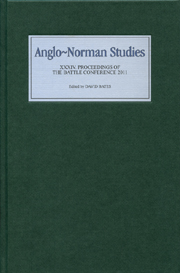Book contents
- Frontmatter
- Contents
- LIST OF ILLUSTRATIONS AND TABLES
- EDITOR'S PREFACE
- ABBREVIATIONS
- Mints and Money in Norman England
- Literate Sociability and Historical Writing in Later Twelfth-Century England
- The Archbishopric of Canterbury and the So-called Introduction of Knight-Service into England
- Lastingham and the Architecture of the Benedictine Revival in Northumbria
- ‘Lanfranc of Bec’ and Berengar of Tours
- The Invention of the Manor in Norman England
- Herbert Losinga's Trip to Rome and the Bishopric of Bury St Edmunds
- Le récit de Geoffroi Malaterra ou la légitimation de Roger, Grand Comte de Sicile
- The Two Deaths of William Longsword: Wace, William of Malmesbury, and the Norman Past
- The Beasts Who Talk on the Bayeux Embroidery: The Fables Revisited
- The Piety of Earl Godwine
The Beasts Who Talk on the Bayeux Embroidery: The Fables Revisited
Published online by Cambridge University Press: 05 April 2013
- Frontmatter
- Contents
- LIST OF ILLUSTRATIONS AND TABLES
- EDITOR'S PREFACE
- ABBREVIATIONS
- Mints and Money in Norman England
- Literate Sociability and Historical Writing in Later Twelfth-Century England
- The Archbishopric of Canterbury and the So-called Introduction of Knight-Service into England
- Lastingham and the Architecture of the Benedictine Revival in Northumbria
- ‘Lanfranc of Bec’ and Berengar of Tours
- The Invention of the Manor in Norman England
- Herbert Losinga's Trip to Rome and the Bishopric of Bury St Edmunds
- Le récit de Geoffroi Malaterra ou la légitimation de Roger, Grand Comte de Sicile
- The Two Deaths of William Longsword: Wace, William of Malmesbury, and the Norman Past
- The Beasts Who Talk on the Bayeux Embroidery: The Fables Revisited
- The Piety of Earl Godwine
Summary
Just as the central frieze of the Bayeux Embroidery depicts Harold dux Anglorum and his milites leaving a second-story banquet hall at Bosham, boarding ship and sailing out to sea, the lower border shows the first in an uninterrupted series of Aesopian fables, the last of which appears just as the English reach land and are captured by a lord called Guy (W 4–8). Previous writers on the embroidery are generally agreed that the series includes eight fables, referred to here as the ‘canonical’ eight to distinguish them from other fables also represented, but rarely if ever noticed. They can be summarized as follows. In Fox and Crow – which reappears first in the lower border, after Harold meets with William, duke of the Normans (W 18), and then in the upper one, as he returns to England (W 27–8) – the crow found a piece of cheese, but the fox tricked him into dropping it and ate it himself. The wolf in Wolf and Lamb met the lamb drinking from a stream and made false charges against him, which the lamb rebutted. But the wolf ate him anyway.5 Bitch and Puppies – which the lower border shows again, shortly before the battle of Hastings (W 59–60) – tells how one bitch loaned her lair to another who was pregnant and later allowed her to keep it until her puppies were older.
- Type
- Chapter
- Information
- Anglo-Norman Studies 34Proceedings of the Battle Conference 2011, pp. 209 - 236Publisher: Boydell & BrewerPrint publication year: 2012



